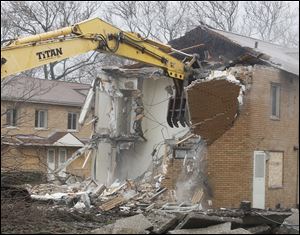
Demolition in City of Toledo hits record numbers
12/13/2011
Work crews begin demolition of the Albertus Brown housing project in Toledo.
The City of Toledo has demolished more blighted homes and other afflicted structures this year than at any point in its history, officials announced Monday.
As of this week, an all-time record of 410 structures have met the city's wrecking ball. That's up from last year's record of 352 properties.
The increase is the result of speedier demolition procedures coupled with additional local and federal money directed at the effort, Public Service Director Ed Moore said.
"We have surpassed our expectations," Mr. Moore enthused. "This is huge. This is the most we've ever done."
A large portion of demolition funding comes from the U.S. Department of Housing and Urban Development, which provided Toledo with more than $1 million this year, according to city officials. That's $750,000 more than the city received for demolition last year, code enforcement manager Bob Mossing said recently.
In addition, Mayor Mike Bell and Toledo City Council allocated $750,000 in local dollars to the cause, which includes $350,000 from the city's capital improvement's fund approved by council in August. The same ordinance has allocated at least another $350,000 toward demolition in 2012.
"We continue to work to eradicate blight in neighborhoods across the city," Mayor Mike Bell said Monday. "Demolition is just one tool to accomplish this."
Abandoned, dilapidated homes are problematic for people living near them because they can pose a safety hazard, attract criminal activities and bring down a neighborhood's property values. It costs an average of $4,250 to demolish a single-family house in Toledo.
Once homes are demolished the remaining land is often turned over to the recently established Lucas County Land Bank, which works to sell it to interested buyers or neighbors, Mr. Moore said.
Yet despite its efforts, Toledo's demolition hit list still tops 600 properties, Mr. Moore indicated. There are no funds to tear down almost a third of those, the Blade recently found. At the same time, more buildings are constantly added to the list, making it difficult to achieve a lasting dent.
A majority of the problem homes are concentrated in the central city and North and East Toledo neighborhoods. Many of them are very old and no longer structurally sound, the director said. The city has been dealing with abandoned properties for almost two decades, Mr. Moore said. However, the financial and housing crises appear to have exacerbated the problem, the Blade recently found.
Mr. Moore said the city will keep working on its demolition efforts.
"As of now I don't see an end. At some point we will get it under control," he said. "There is no new goal. We'll just keep going with it and see where we end up."
Councilman Mike Craig, who pushed for the additional money for demolition earlier this year, said he is pleased with the results so far but wants to see more.
"Their demolition goal was met but that doesn't mean that the need was met," Mr. Craig said. "We're going to have to have another banner year next year, regardless of budget cutbacks, to keep the neighborhoods viable and livable."
The cost to the city of tearing down a home is far less than the economic fallout from letting blighted structures stand, Mr. Craig argued. Demolishing abandoned structures helps stabilize property values and keep more residents from leaving a neighborhood, he said.
Contact Claudia Boyd-Barrett cbarrett@theblade.com or 419-724-6272.